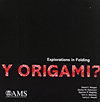- About MAA
- Membership
- MAA Publications
- Periodicals
- Blogs
- MAA Book Series
- MAA Press (an imprint of the AMS)
- MAA Notes
- MAA Reviews
- Mathematical Communication
- Information for Libraries
- Author Resources
- Advertise with MAA
- Meetings
- Competitions
- Programs
- Communities
- MAA Sections
- SIGMAA
- MAA Connect
- Students
- MAA Awards
- Awards Booklets
- Writing Awards
- Teaching Awards
- Service Awards
- Research Awards
- Lecture Awards
- Putnam Competition Individual and Team Winners
- D. E. Shaw Group AMC 8 Awards & Certificates
- Maryam Mirzakhani AMC 10 A Awards & Certificates
- Two Sigma AMC 10 B Awards & Certificates
- Jane Street AMC 12 A Awards & Certificates
- Akamai AMC 12 B Awards & Certificates
- High School Teachers
- News
You are here
Y Origami?: Explorations in Folding

Publisher:
American Mathematical Society
Publication Date:
2017
Number of Pages:
142
Format:
Paperback
Price:
39.00
ISBN:
9781470436742
Category:
General
[Reviewed by , on ]
Mark Causapin
03/28/2018
The foreword by a renowned origami expert, Robert Lang, gives a poetic narrative about the link between the art of origami, engineering, and mathematics. It is a succinct description of origami’s history and contributions that excites and pulls readers to learn more about it. It sets the tone for the fusion of art and mathematics that this book attempted to portray.
Following it is the introduction written by the authors that gives the practical details: the background of the project, the funders of their work, and their main goal in producing this book, which is to demonstrate the potential of origami to improve the ways things function, to simplify how products are made, and to create new objects that would otherwise be impossible to create. For each product they present, they juxtapose the origami that inspired it.
This book is meant be an artistic and visual compilation. I believe it is effective in conveying how origami truly inspired engineering work. I have two negative comments about this book, however, neither of which is about the origami nor about the mathematics.
First, as this book is very visual and artistic, it is disappointing to see how low the quality of the pictures is. Many images are pixelated and the resolution seemed to be inappropriate for publishing. Some seem amateurish. The deployable solar array project, for instance, is fascinating, but the pictures showing how it is deployed in space look like a screen grab from a video. Similarly, the oriceps product used in surgery appears very pixelated. The circle/circle table looks beautiful, but the picture has very low resolution. Finally, the whole beauty bag product’s origami demonstration could have been done better. It seemed like the picture of the origami shown was the one used during the pre-production and conceptualization of the product.
Second, the learning activities part seems unfinished. It is a mishmash of mathematical theorems, placed with their origami visualizations. There is no coherent presentation of origami. The steps in doing origami are also not clear. Some of the notations are confusing and the labels for the different types of folds are not explained very well. Some simply show the final folded paper configuration without the necessary steps to reach this stage. I doubt an instruction like “Crease along all lines as indicated using the pattern on the right,” followed by a complicated paper fold, will be helpful to readers.
The last part of the book, on the “new origami”, is very interesting. The origami shown is beautiful, and there is an attempt to allow readers to see the tessellations and patterns formed. I doubt the authors intended the readers to recreate them.
Overall, I was able to see the authors’ vision for this book. It is a good book with beautiful ideas, but it seems unfinished and indeed in its proofing stage. Perhaps, in a second iteration, the limitations of this book could be fixed and it would truly be a work of art.
Mark Causapin is an Assistant Professor of Mathematics at Aquinas College in Nashville, Tennessee.
See the table of contents in the publisher's webpage.
- Log in to post comments




